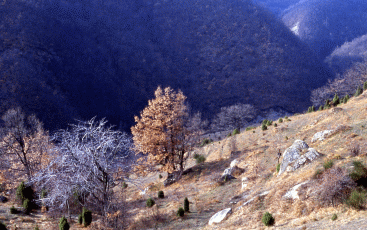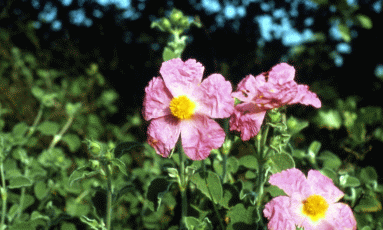 Montalto
and Careste, going on to Ruscello, and from here to Valbiano or the
facciano Mount (936 m.), until Quarto and its lake, represent one of the
most interesting, naturalistic areas of the Appennin "Cesenate".
In virtue of its environmental value, this area has been included by the
Emilia-Romagna Region, within the project "Rete
Natura 2000" - among the Sites of Communitarian Interest (SIC)
with the denomination: IT4080010 - Careste
presso Sarsina. Montalto
and Careste, going on to Ruscello, and from here to Valbiano or the
facciano Mount (936 m.), until Quarto and its lake, represent one of the
most interesting, naturalistic areas of the Appennin "Cesenate".
In virtue of its environmental value, this area has been included by the
Emilia-Romagna Region, within the project "Rete
Natura 2000" - among the Sites of Communitarian Interest (SIC)
with the denomination: IT4080010 - Careste
presso Sarsina.
The project "Rete Natura 2000"
originates from the directive of the European
Union n. 43/1992 named "Habitat". This project aims at
preserving the biological variety in the territories of the Union itself
and, in particular, at protecting a series of habitats, animal and
vegetals species which are rather rare. The directive in question
provides that the States of the European Union contribute to the
constitution of the Natura 2000 ecologic net, just in function of the
presence on their territory of these natural habitats and rare species
of plants and animals.
The place includes a submontane area,
characteristic of the Appannino "Cesenate", situated between
Borello and the Savio river, near Sarsina. Around the aerial,
semicircular spur of Careste, which slopes down north, towards the Rio
Cella-Ranchio and south towards the Molinello ditch (with ita famous Marmitte
dei Giganti) the landscape is characterized by sandstone hillsides,
with the strong presence of marly-calcareous parts, where we find both
hills and submontane woods, alternated by valleculae at intervals
intensively eroded.
A dirt road runs circularly across this
area and it follows, in its highest stretch, the ridge between the Savio
and the Borello valley. Except for a few settlementes, the territory is
characterized by the presence of ruins and abandoned churches. Of a
particular interest are the seventeenth-century church of St. Andrea, in
Careste, situated just on the ridge between the two valleys, and the
curch of Sy. Salvatore, in Montalto, from which the precious bas-relief
of the high altar in the cathedral of Sarsina comes.
 The
area, which was in the past populated by rural settlements, occupies the
north part of the wide State demesne "Foresta di Careste-Sarsina".
Woods, which cover more than the 50% of the area, mainly with coppices,
present actually quite a modest development, and are frequently extended
and reinvigorated with conifers (especially with Scoth pines and stone
pines). The
area, which was in the past populated by rural settlements, occupies the
north part of the wide State demesne "Foresta di Careste-Sarsina".
Woods, which cover more than the 50% of the area, mainly with coppices,
present actually quite a modest development, and are frequently extended
and reinvigorated with conifers (especially with Scoth pines and stone
pines).
Grasslands and uncultivated lands alternate with garrigues, bushes and
shrubs, especially of juniper. This kind of vegetation creates a
suitable habitat for orchids which grow thick and luxuriant.
The management of this site does not present any relevant obstacle or
risk since the area is unhinabitated and there is already a forest
regulation which will increase the number of big or marcescent trees
with hollows for the fauna. Three habitats of Community interest cover
altogether about the third of the surface of the site.
Vegetation
The woods, altered by the
repeated and intense fellings, are dominated by hornbeams, durmasts,
manna-ashes but also, in some areas, by Turkey oaks, chestnuts, sorbs
and maples. More interesting are the various species of bushes, which
often alternate with semiarid grasslands and garrigues. These kinds of
vegetation are in different phases of development, mostly slown down by
the general conditions of poor fertility.
IThe common Juniper and the genista are probably the most diffused
species, together with another specie of juniper, the Juniperus oxycedrus
var. rufescens, especially in the warmest sectors and
curiously associated with the Polygala
chamaebuxus and the Calluna vulgaris, (north european
species) or with the Cistus incanus and the Cotynus coggygrya.
The entire place represents, besides, the ideal habitat for the orchids:
here we can find, even under the thin covering of the coniferous trees,
various uncommon species such as the Aceras antropophorum, the Himantoglossum adriaticum,
the Serapias spp. and the Ophrys.
Fauna
As far as the avifauna is
concerned, we have a great number of woodlarks (Lullula arborea)
and shrikes (Lanius collurio), as well as about ten species which
are typical of the agricultural and hill habitat. As for the mammals, we
can find porcupines, polecat and Eliomys quercinus. Among the
minor vertebrates we count the newt (Triturus
carnifex), the Esculapius' snake and the tree frog. Among the
invertebrates, we have the insects Percus
passerinii, the Isotomus barbarae, and the Nebria fulviventris.
An up-to-date faunal census, with a special reference to the forestal
chiropterans, will be able better to define the presence of species
which have not been verified yet.
The entire area is fit for interesting
excursions thanks to the charme and splendour of its landscapes as well
as its vegetation and animal species.
|
 Montalto
and Careste, going on to Ruscello, and from here to Valbiano or the
facciano Mount (936 m.), until Quarto and its lake, represent one of the
most interesting, naturalistic areas of the Appennin "Cesenate".
In virtue of its environmental value, this area has been included by the
Emilia-Romagna Region, within the project "Rete
Natura 2000" - among the Sites of Communitarian Interest (SIC)
with the denomination: IT4080010 - Careste
presso Sarsina.
Montalto
and Careste, going on to Ruscello, and from here to Valbiano or the
facciano Mount (936 m.), until Quarto and its lake, represent one of the
most interesting, naturalistic areas of the Appennin "Cesenate".
In virtue of its environmental value, this area has been included by the
Emilia-Romagna Region, within the project "Rete
Natura 2000" - among the Sites of Communitarian Interest (SIC)
with the denomination: IT4080010 - Careste
presso Sarsina.
![]()